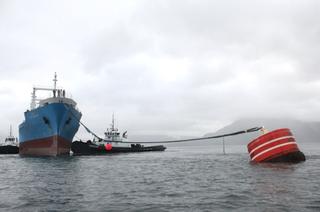Unalaska Tries to Plan Ahead for Distressed Vessels

Tuesday, October 08 2013
The thousands of cargo ships that sail through Unimak Pass will soon meet nasty fall storms. As a port of refuge, Unalaska is where they will go in emergencies -- and the city's new emergency mooring buoy is where they'll tie up.
But as KUCB’s Ben Matheson reports, the buoy is going to need some support of its own.
On a calm fall morning near Unalaska, a tall, 377-foot reefer -- the Number 1 Pohah -- is a dead ship.
With no engine power, it’s at risk of running aground with thousands of gallons of fuel onboard. Or, rather, it’s playing that role, for the purpose of the city's annual emergency towing drill.
[Sound of lapping water]
Two tugs tie in and pull the Pohah to the large orange and white emergency buoy. Crews snag the buoy’s line and pound the heavy steel shackles to connect to the Pohah.
[Sound of hammering]
The port has wanted this buoy for years. It took a lot of donations and grants to cover the $10 million price tag. Shell Oil was the biggest donor and gave the port the anchors and buoy. They even installed them for free in a protected bay outside town.
Unalaska mayor Shirley Marquardt says it got the city off to a good start.
Marquardt: "
The city’s trying to come up with some kind of schedule for performing that work. This spring, they paid PND Engineering $18,000 to write them a plan, which is still in process.
Ports Director Peggy McLaughlin says at a minimum, there will be annual inspections. Some of that can be done with a remotely operated vehicle, which they can send underwater to capture images of the chains and connection points.
But that’s the easy part. Eventually, McLaughlin says they’ll have to check on the part of the buoy that’s actually in the seafloor.
The city is still trying to figure out how to pay for this. Unalaska’s city council approved a tariff schedule for the buoy this summer. The biggest vessels will pay over $3,000 dollars a day to tie up.
The port says there were at least four vessels last year that would have used the buoy in emergencies, but it’s anyone’s guess how many distressed boats will use it.
For all of the days when it sits empty, the city will allow non-distressed ships to tie up. Mayor Marquardt says the fees from that will go directly into a maintenance fund. McLaughlin says that maintenance budget is up in air -- but whatever it ends up being, she thinks the cost will be worth it.
Back on the water, the Pohah reefer is nowhere near splitting apart. It’s securely tied in to the emergency buoy:
Tow Crew: "Yeah, we've got to get a pretty good purchase on it."
And while the drill goes well, there are still some kinks to work out. A section of heavy-duty line appears to have frayed, which will require some extra testing to make sure it’s safe to use.
Overall, though, the buoy gets a passing grade -- which means that the next time a distressed vessel is seeking safe harbor in the Aleutians, they’ve got a place to go.



